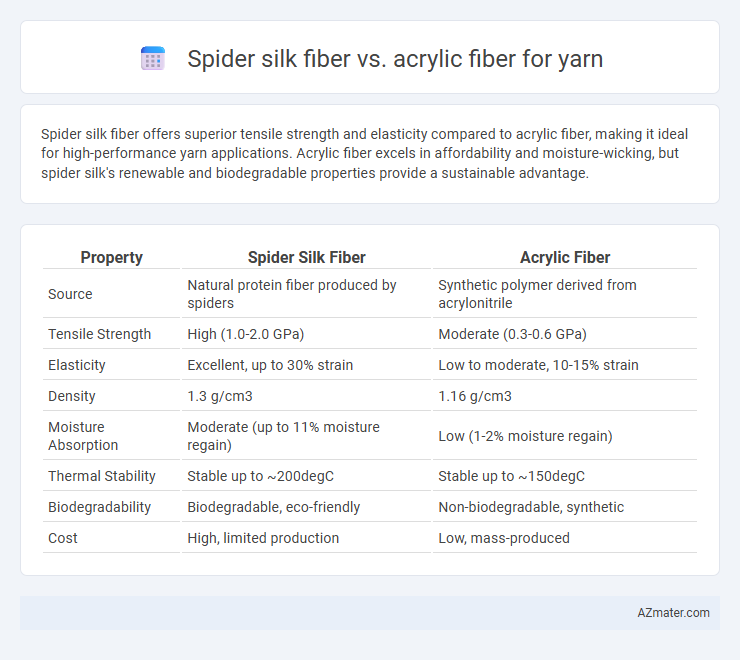Spider silk fiber offers superior tensile strength and elasticity compared to acrylic fiber, making it ideal for high-performance yarn applications. Acrylic fiber excels in affordability and moisture-wicking, but spider silk's renewable and biodegradable properties provide a sustainable advantage.
Table of Comparison
| Property | Spider Silk Fiber | Acrylic Fiber |
|---|---|---|
| Source | Natural protein fiber produced by spiders | Synthetic polymer derived from acrylonitrile |
| Tensile Strength | High (1.0-2.0 GPa) | Moderate (0.3-0.6 GPa) |
| Elasticity | Excellent, up to 30% strain | Low to moderate, 10-15% strain |
| Density | 1.3 g/cm3 | 1.16 g/cm3 |
| Moisture Absorption | Moderate (up to 11% moisture regain) | Low (1-2% moisture regain) |
| Thermal Stability | Stable up to ~200degC | Stable up to ~150degC |
| Biodegradability | Biodegradable, eco-friendly | Non-biodegradable, synthetic |
| Cost | High, limited production | Low, mass-produced |
Introduction to Spider Silk and Acrylic Fibers
Spider silk fiber exhibits remarkable tensile strength, elasticity, and biocompatibility, derived from protein-based natural polymers spun by spiders. Acrylic fiber, a synthetic polymer primarily composed of polyacrylonitrile, offers high durability, resistance to chemicals, and low moisture absorption, making it widely used in textile manufacturing. Both fibers serve distinct purposes in yarn production, with spider silk excelling in performance and sustainability while acrylic fibers provide cost efficiency and versatility.
Origins and Production Methods
Spider silk fiber originates from the natural secretion of spiders, harvested through careful milking or synthesized using genetic engineering techniques involving recombinant DNA technology in host organisms like bacteria or yeast. Acrylic fiber is a synthetic polymer produced through the polymerization of acrylonitrile monomers derived from fossil fuels, followed by fiber extrusion via wet or dry spinning methods. The production of spider silk emphasizes biomimetic and sustainable processes, while acrylic fiber relies heavily on chemical synthesis and industrial-scale manufacturing.
Physical Properties Comparison
Spider silk fiber exhibits exceptional tensile strength of up to 1.3 GPa and a high elongation at break around 30%, making it more resilient and flexible compared to acrylic fiber, which typically has tensile strength near 0.3 GPa and elongation of 15-25%. The density of spider silk is approximately 1.3 g/cm3, significantly lower than acrylic fibers at around 1.18 g/cm3, contributing to its lightweight nature without compromising durability. Moreover, spider silk offers superior moisture-wicking and thermal regulation properties, whereas acrylic fibers are less breathable and tend to trap heat and moisture.
Strength and Durability Analysis
Spider silk fiber exhibits exceptional tensile strength, often surpassing that of steel by weight, making it one of the strongest natural fibers used in yarn production. Acrylic fiber, while moderately strong and lightweight, tends to degrade faster under prolonged UV exposure and mechanical stress, leading to reduced durability compared to spider silk. The superior elasticity and resilience of spider silk result in longer-lasting yarns capable of withstanding higher stress without significant wear or breakage.
Elasticity and Flexibility
Spider silk fiber exhibits superior elasticity compared to acrylic fiber, stretching up to five times its original length without breaking. Its exceptional flexibility allows it to bend and twist without losing strength, making it ideal for applications requiring durable and adaptable yarn. In contrast, acrylic fiber offers moderate elasticity and flexibility but tends to lose shape over time under repeated stress.
Environmental Impact and Sustainability
Spider silk fiber outperforms acrylic fiber in environmental impact, as it is biodegradable and produced through sustainable bioengineering processes that require minimal water and energy. Acrylic fiber, derived from petrochemicals, contributes significantly to carbon emissions and microplastic pollution due to its synthetic, non-biodegradable nature. Sustainable yarn production increasingly favors spider silk for its low ecological footprint and renewable source, positioning it as an eco-friendly alternative to conventional acrylic yarns.
Comfort and Wearability
Spider silk fiber offers exceptional comfort and wearability due to its natural elasticity, breathability, and lightweight texture, which closely mimics the properties of human skin. Acrylic fiber, while durable and resistant to moisture, lacks the same level of softness and breathability, often resulting in reduced comfort and increased moisture retention during prolonged wear. The hypoallergenic nature of spider silk further enhances its suitability for sensitive skin, making it a superior choice for high-end, comfortable yarn applications.
Applications in the Yarn Industry
Spider silk fiber excels in high-performance yarn applications due to its exceptional tensile strength, elasticity, and biodegradability, making it ideal for eco-friendly, durable textiles and advanced medical sutures. Acrylic fiber, widely used in the yarn industry, offers affordability, moisture resistance, and vibrant color retention, suitable for mass-market apparel, upholstery, and knitwear. The choice between spider silk and acrylic fibers depends on balancing sustainability and high performance against cost-efficiency and widespread availability in textile production.
Cost and Accessibility
Spider silk fiber offers exceptional strength and elasticity but remains significantly more expensive and less accessible than acrylic fiber due to complex harvesting methods and limited production scale. Acrylic fiber is widely available, cost-effective, and mass-produced, making it a popular choice for affordable yarn applications. Cost per kilogram for spider silk can exceed thousands of dollars, while acrylic fiber costs typically range from $1 to $3 per kilogram, highlighting the stark contrast in accessibility and affordability.
Future Trends and Innovations
Spider silk fiber exhibits exceptional tensile strength, biodegradability, and elasticity, positioning it as a revolutionary material in sustainable yarn production. Innovations in bioengineering and synthetic biology aim to enhance spider silk yield and cost-efficiency, driving its adoption in high-performance textile applications. Acrylic fiber, while widely used for its affordability and durability, faces increasing competition from eco-friendly alternatives like spider silk as consumer demand shifts towards sustainable and multifunctional fabrics.

Infographic: Spider silk fiber vs Acrylic fiber for Yarn
 azmater.com
azmater.com